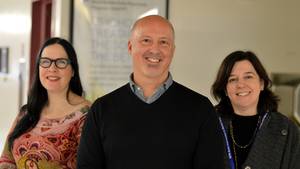If you’ve been waiting in line to ride the Space Mountain rollercoaster and staff ask you to sign a consent form, you’ll likely do it with a smile — and without reading the form.
Dr. Greg Hirsch, the chief cardiac surgeon at the QEII Health Sciences Centre, says the same thing tends to happen when patients are asked to give consent to a medical procedure. “When you dig deeper and talk to patients, you find they don’t really understand what you’re telling them.”
Asked for the surgeon’s name, the procedure’s name, or any complications they might face, they draw a blank. “We think it’s a crisis in cardiac surgery.”
He thinks it can get better and is using a QEII Foundation Translating Research Into Care (TRIC) grant to explore shared decision making (SDM), a formalized approach to involving patients in clinical decisions.
“We’re the first group in North America to do this in cardiac surgery,” he says.
Imagine an 86-year-old man with a leaking heart valve who can still drive and live independently. He might value quality of life over longevity. “That turns some of the decision making on its head.”
With the SDM approach, Dr. Hirsch would tell him that getting his heart fixed could add years to his life when he’s about 90. But it would come with a 10 to 15 per cent risk that he will lose his independence. Given this information, he might decide against surgery and keep his good life.
But a 41-year-old mother of young kids would see those odds, see her family, and want to “live at any cost,” accepting the risks.
The first step of SDM is “activating” the patient so they know what role they can play in their own care. Next comes education on the options and the likely outcomes. He uses “decision matrices” with the patients to make clear what risks come with different decisions.
“Our decision aid has not just generic information, but that actual patient’s computed risk,” he says.
The TRIC grant let them trial SDM and create an online version of the decision aid. Dr. Hirsch’s cardiac team is working with the geriatrics department, too, along with grad students.
Their goal is to roll out SDM for all patients 65 and older facing heart operations. Research shows SDM improves patient comprehension and reduces post-decision regrets.
That was Joy Manning’s experience when she used SDM with Dr. Hirsch when she had a problem with a heart valve. “I met with Dr. Hirsch and he just puts you right at ease,” the 79-year-old Nova Scotian says. “He explained everything from the charts he had in there. I was a little nervous when I first went in, but I came out feeling completely different.”
Joy’s 64-year-old brother had died from heart problems and her mother and another brother had open-heart surgery. “Dr. Hirsch told me the decision was mine, but if I didn’t have the surgery I had less than two years.”
She then met with a team of medical professionals and got a good understanding of everything that would happen, from the procedure to the implications for her medication.
“When I was being wheeled in for the operation, I was really relaxed. I knew that I was going in for something serious, but at the same time, I had a lot of faith in what was ahead of me. I knew I had a good doctor,” Joy says.
Dr. Hirsch says that’s exactly how it should go. “One of our mantras is we never make a decision the same day we roll out the options. We sleep on it if it’s not an emergency.”








